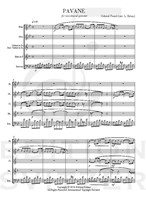
Pavane (Op. 50)
Composer: Gabriel Fauré
Instrument: Woodwind Quintet
Level: unknown
Published: 2014
Price: €22.00
Item details
-
Description +
-
Arranged by Lior Eitan
Duration: 6 min.
The original version of the Pavane op. 50 by Gabriel Fauré, was written for piano in 1887. It obtains its name from the slow processional Spanish court dance of the same rhythm.
The composer described it as "elegant, but not otherwise important". Fauré composed the orchestral version in the summer of 1887. He scored it for a small orchestra, consisting on strings and one pair each of Flutes, Oboes, Clarinets, Bassoons and Horns, to be played at a series of light summer concerts. After dedicating the work to his patron, Countess Greffulhe, he felt obliged to stage a grander affair and at her recommendation he added an invisible chorus to accompany the orchestra (with additional allowance for dancers). The choral lyrics were based on a text telling about the helplessness of man, which had been contributed by the Countess's cousin.
The orchestral version was fi rst performed on November 25, 1888. Three days later, the choral version was premiered. In 1891, the Countess finally helped Fauré produce the version with both dancers and chorus, in a "Choreographic Spectacle" designed to grace one of her garden parties in the Bois de Boulogne.
The Pavane has enjoyed great popularity, whether with or without chorus. With choreography by Léonide Massine a ballet version entered the repertoire of Sergei Diaghilev's Ballet in 1917, and he kept it in the company's repertoire until the end of his life.
-
-
Instrumentation +
-
Woodwind Quintet:
Flute
Oboe
Clarinet
Horn
Bassoon
-
-
About the composer +
-
Gabriel Urbain Fauré (12 May 1845 – 4 November 1924) was a French composer, organist, pianist and teacher. He was one of the foremost French composers of his generation, and his musical style influenced many 20th-century composers. Among his best-known works are his Pavane, Requiem, nocturnes for piano and the songs "Après un rêve" and "Clair de lune". Although his best-known and most accessible compositions are generally his earlier ones, Fauré composed many of his most highly regarded works in his later years, in a more harmonically and melodically complex style.
-
-
Credits +
-
Front Cover graphics and layout: Ronni Kot Wenzell
Engraving: Ary Golomb
Printed in Copenhagen, Denmark
Copyright © Edition SVITZER
www.editionsvitzer.com
-





